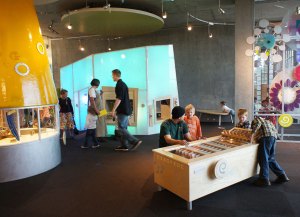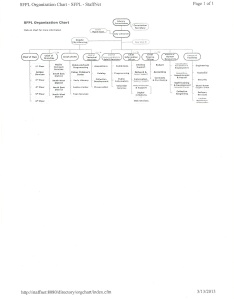About five years ago, a multicolored object with many wooden panels sprang up in the children’s room at San Francisco Public Library (SFPL). While it was built, the chief of children and youth services and the library’s early literacy specialist watched closely. I wondered what it was doing in the library and how much it cost.
I got a clue about its purpose while observing a children’s librarian conduct a story hour, called “baby rhyme time,” for a group of parents and their babies. It took place in the storytelling room, adjacent to the mysterious structure. They started out singing “I’m a little baby, I fly high, Down to the floor and up to the sky.” I noticed the repetition of the sound of words and thought about alliteration in poetry. Could demonstrating the sounds of words be a way to teach babies about language, I wondered.
I went back to the panel. I noticed the many plastic, colored letters and numbers on its walls as well as poems in English, Spanish and Chinese. One I remembered from my childhood: “Wynken, Blynken and Nod one night sailed off in a wooden shoe: sailed off on a river of crystal light, into a sea of dew.” This is a poem about dreaming which was also made into a song:
https://youtu.be/sal_pp_ptJQhttp://www.youtube.com/watch?v=sal_pp_ptJQ&rel=0
I wondered if librarians could use songs because they convey sound to teach children how to read and write (Balderas, R. personal communication, 2013). I also noticed other poems on the panel, including the Carl Sandburg poem, beginning with “The fog comes on little cat feet,” and “Twinkle, twinkle, little star.”
One librarian said that during his story hours he tries to promote awareness of print, show children that they see writing in their environment and teach them that print is important (Balderas, R. personal communication, April 13, 2013). His approach to story hours offers some clues about understanding this site.
Next to the letters on the site were words that included letters, such as “B is for bugs and beetles,” next to to a picture of a ladybug. I also noticed that some sentences like “G” is for garden” were next to images of flowers. Placing these letters next to images helps children connect everyday images with words and sentences.
Another feature of this site is called “spin a story,” and teaches children about story structure and narrative skills (Anderson, M., personal communication, April 12, 2013). It has four wheels with categories like “what happened on baby’s birthday;” ‘who came;” “which present/what was inside;”? and “how does baby feel?,” and includes images of these concepts on each wheel.
I also noticed a slide ruler where children can measure their height, next to the sentence, “H is for height.” This ruler provides a way for children to develop their concept of quantity (Diamant-Cohen, B., Prendergast, T., Estrovitz, C., Banks, C., & van der Veen, K., 2012 ). A three dimensional wooden structure, a replica of Lombard Street, the crookedest street in San Francisco, is another feature on this site. A curvy track on each side borders the raised wooden panel and kids can throw wooden balls down it or push them up it, but the balls stay on the track. Words like “back and forth” are written next to the track, so children can connect words with the structure of Lombard Street. Here, children can learn about spatial relation as well as how gravity works.
This play to learn site reflects the library’s early literacy initiative based on the Every Child Ready to Read (ECRR) curriculum that the Public Library Association (PLA) and Association of Library Services for Children (ALSC) launched.(Estrovitz, C. personal communication, April 10, 2013). Every Child Ready to Read began in 2004. The most recently revised Every Child Ready to Read @ your library includes play as a way to learn early literacy skills. Play involves the use of imagination and experimentation rather than memorizing information. (Diamant-Cohen, B. et al 2012). A movement among children’s librarians to advocate play began in part, as a reaction against the No Child Left Behind law, which required teachers to prepare students to take standardized tests, or lose their funding (2012). This philosophy of education seems to have filtered down to some members of the early childhood community (2012).

Early literacy spaces have sprung up in various libraries across the country. The largest one is in the Vancouver (Wash.) Community Library, which opened in 2011 (2012). The Burgeon Group, a Phoenix- based company, created both the early literacy space for San Francisco Public Library and the one for the Vancouver Community Library.
Another way that children learn about language is by interacting with adults about its features (Jeske, Jim, personal communication, April 11, 2013). I watched one afternoon, while a boy who was about four-years old played at the site. He pushed the wooden balls up and down the track next to the model of Lombard Street. He also picked up one of the colored letters, noticed that I was writing, and came over and said the name of the letter. He then asked me to write the letter. He watched, then picked up another letter, and asked me to write it, and this game continued until I had written five or six letters and said that I wanted to stop. I speculated that this boy might be learning to read or write. Later that day, I noticed several children, who kept pushing the ball up and down the curved tracks on the model of Lombard Street, as if it was a never ending game.
According to Diamont-Cohen, B. et al, “Since play is truly how children learn, the time is ripe to explore how that play relates to collections, programs, space and how play can be integrated into the library” (p. 10).
References
Diamont-Cohen, B., Prendercast, T., Estorvitz, C., Banks, C. & van der Veen, K.(2012, Spring). We Play Here! Children and Libraries. pp. 3-18, &52. Retrieved from http://burgeongroup.com/burgeonpublication1.pdf
Public Library Association & Association for Library Services to Children. (2011). Every Child Ready to Read @ Your Library. Retrieved From http://www.everychildreadytoread.org/project-history%09/literature-review-2010
Stephens, M. (2013). Library Learning and New Literacies. {Lecture}. LIBR 287-The Hyperlinked Library. Retrieved from http://thehyperlinkedlibrary.org/hyperlib/readings-and-more/learning-new-literacies/






